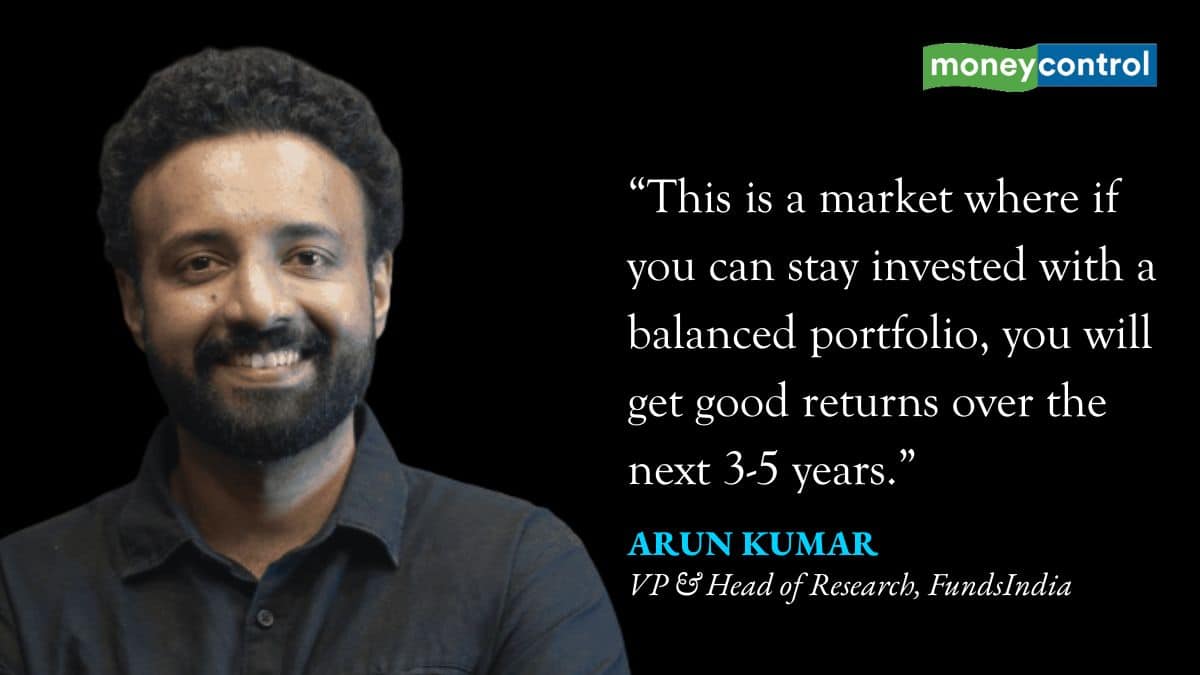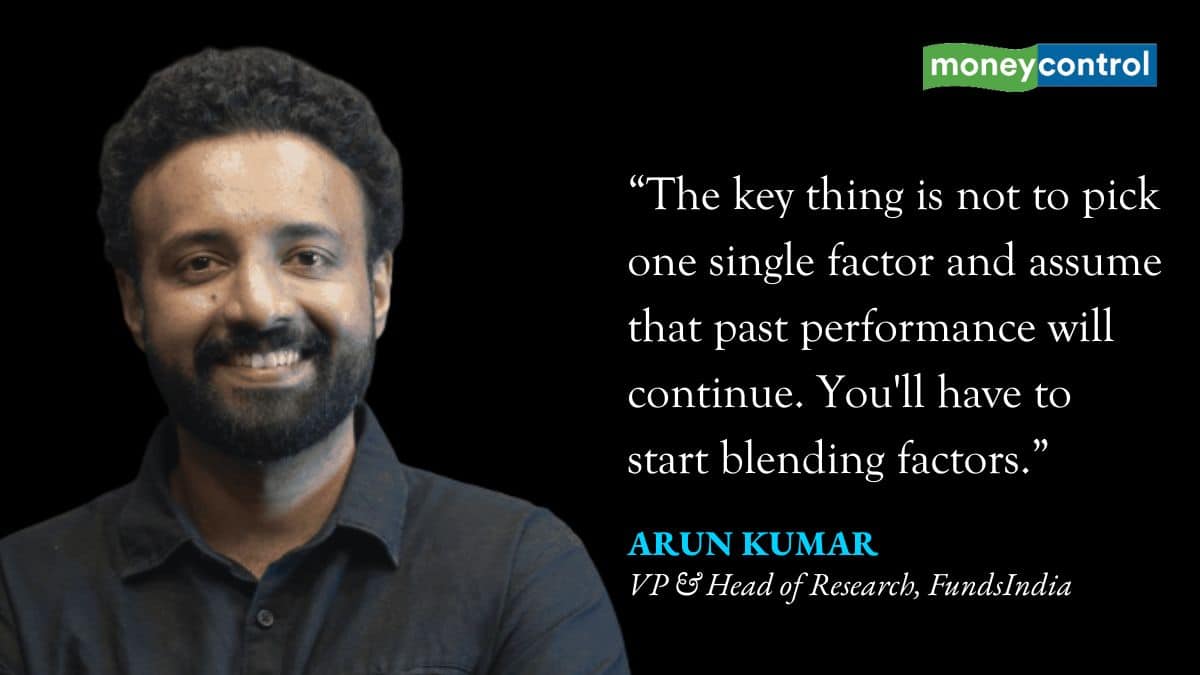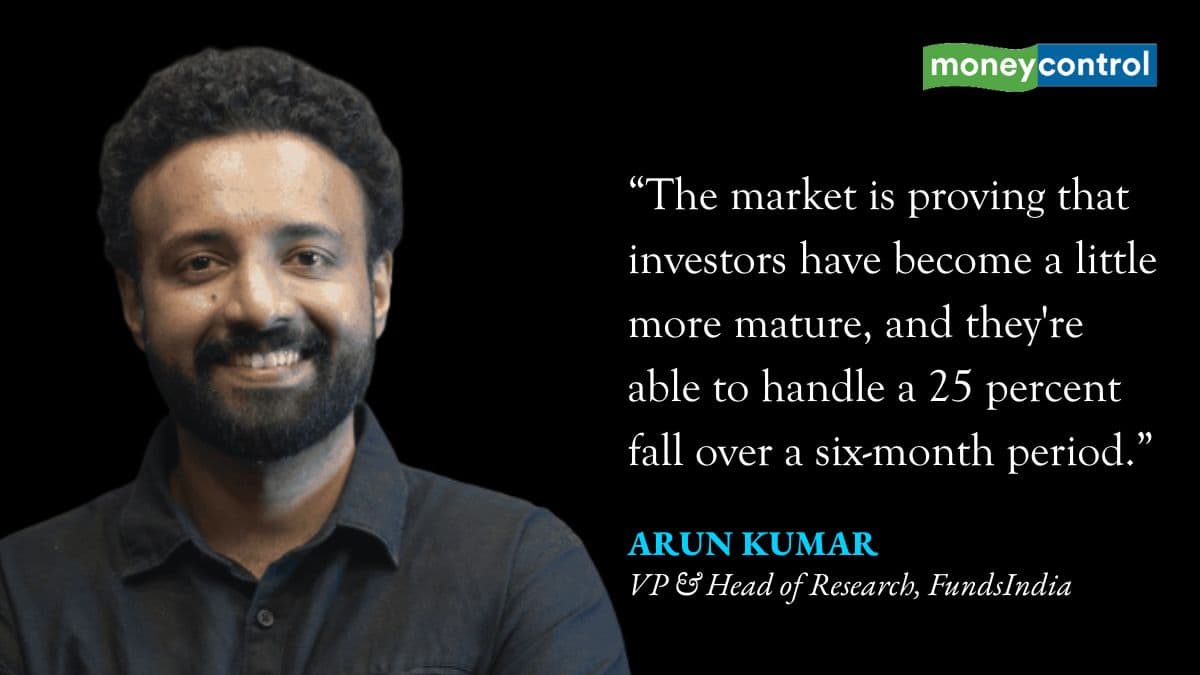



Smart beta funds or rule-based investment strategies have picked up in a big way in the Indian mutual fund industry. In an interview with Moneycontrol, Arun Kumar, vice president and Head of Research at FundsIndia, said "we will need at least five years to figure out which rule is good enough to play a specific factor".
He says that a portfolio can be built on smart beta funds today, but investors need to be very careful, as there can be a big difference between the index returns and the fund returns.
He also talked about the changing styles of Indian investors over the last few years and the likelihood of a slowdown in the gush of new sectoral and thematic funds.
Edited Excerpts:
How would you describe the Indian market in 2025?
In terms of valuations, we are somewhere in the neutral zone. We have an internal metric, where we plug four metrics -- price-to-equity, price-to-book, bond yields-to-earnings yields, and market cap-to-GDP.
Usually, when the metric crosses 80, it becomes expensive, while 90 is where we get really get worried. Between 50 and 70 is the neutral band, and anything below 50, you make phenomenal money over the next three years. We almost touched the 50 level in the recent market bottom in the last two-three months. But now, we are again back to neutral levels.
Also read | The myths and realities of being an Accredited Investor
The markets are not very expensive. This has more to do from the large-cap side. Obviously, midcaps and smallcaps are slightly on the expensive side. If you put all these things together, our view is that we are still in the midway of the bull market cycle.
It's a very neutral market, where if you're not overly concentrated in any of the styles or sectors or market caps, you should do well. This is a market where if you can stay invested with a balanced portfolio, you will get good returns over the next 3-5 years.

What should be the investors’ strategy?
The idea is not to get carried away by one of the approaches. The problem is that portfolios might get concentrated in either smallcaps or sectors such as defence or PSUs, which have done well in the recent past. However, in a bull market, the idea is not to get carried away and stay across the styles.
Right now, largecaps is a very simple call -- you can just buy and hold. On the other hand, you can buy smallcaps and midcaps, but they need monitoring at a very high frequency.
Do you think this gush of sector and thematic funds will slow down now?
I thought that new funds would stop because, at one point earlier, almost 50 percent of the equity mutual fund flows were going into sectoral/thematic funds. Now again, sector funds have started to do well.
Narratives are a lot easier to build in sectoral funds, and there is always a tendency for investors to assume that something new is better.
As long as we are in a bull market, sectoral/thematic launches will continue, unless there's a very sharp correction leading to a bad experience.
Do you think factor-based passive funds or rules-based investment strategies are a fad or a lasting investment strategy?
If you look at the Nifty50, it's a rule-based index, which shows the top 50 stocks by size out of the top 500 stocks.
Now, the challenge with these new rule-based investment strategies is that they are back-tested. While the Nifty50 has been fairly tested for a long period, in terms of liquidity, you will find that there will be a lot more leakages in new strategies because they have been backtested for a particular environment. Each factor might do well for some years, and then not do well for some years. So there will be cyclicality to these factors.
Also read | Gold is climbing again. Is it time to take some profits or stay invested?
The key thing is to not pick one single factor and assume that the past performance will continue. You'll have to start blending factors. You'll have to pick at least four or five different factors. The challenge is to figure out which fund to represent that factor, because for each and every factor, you have at least 10-15 fund options.

The real point is that there is also an execution challenge for funds. For example, there was an Alpha 50 fund where the top two stocks couldn't be bought because they were very illiquid. Imagine if the top two stocks of your strategy cannot be bought. In this case, the index cannot be replicated in real life.
There'll be a lot of leakages between the actual and the real-life return in many of these new factor-based strategies. I think we are in very early stages. We'll at least need five years to figure out what rule is probably decent enough to play that factor, and also how good that can actually be replicated, in terms of returns by an index.
Can a portfolio today be made based on these smart beta funds?
They can be, technically. You can pick 4-5 different styles and then build it. But do I have the comfort? I don't because most of these are still rules, which have only been back-tested. There is some structure to these rules, it's not like they're blindly backtested. However, you should at least give a leakage of around 1 percent in terms of returns.
And if the factor is very high churn and very low when it comes to market capitalisation, probably you should give it more margin of safety.
My preference is still to go for active funds at this juncture. We're still not at a stage where it has become very hard for active to outperform passive funds. In aggregate, there might be a lot of funds which are struggling, but for your portfolio, you technically need only five funds.
Amid the recent market turbulence, we saw a rise in SIP stoppages. How do you read that?
I think that the metric is a little skewed because what it does is that it only gives incremental information. The data, for example, shows that if 100 new SIPs are started in a month, and 50 are stopped, it comes in a percentage of either above 100 or below that.
If you look at the percentage of SIP stoppages versus the overall existing SIPs, it's almost like a rounding-off error. The better number to watch out for is the overall net SIP flow, which is very stable.
Also read | Home loan dilemma: Should you prepay or invest after repo rate cut?
We should be worried when monthly SIP inflows start sharply deteriorating.
Do you think investors are back to chasing recent performers, or the risk perception has increased?
Chasing recent performers will always be there. A major concern is that almost 75 percent of investors today have entered after the COVID-19 outbreak. They are yet to experience a long cycle, where smallcaps do badly.
The good thing was that in the recent correction, we did not see any mass panic on smallcaps, where some 25-percent correction was digested really well by investors. The real problem would be a very large correction, which would probably last for one-two years.

The market is proving that investors have become a little more mature, and they're able to handle a 25 percent fall over a six-month period.
Discover the latest Business News, Sensex, and Nifty updates. Obtain Personal Finance insights, tax queries, and expert opinions on Moneycontrol or download the Moneycontrol App to stay updated!
Find the best of Al News in one place, specially curated for you every weekend.
Stay on top of the latest tech trends and biggest startup news.